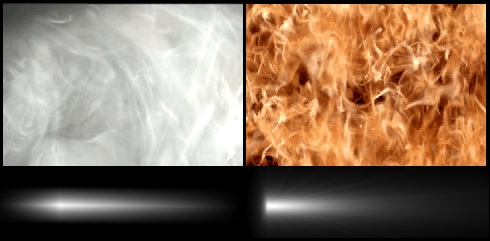Video Streams on Models
STK Engine's
VideoStream can be utilized by many classes within the library,
including COLLADA models.
This allows you to stream video to a model's textures. The models
are self contained, so you can distribute the models and videos and
they can be used in other STK Engine applications. Any image that
is used by a COLLADA model for texturing can be replaced with a
video. To allow for interoperability with different 3D modeling
applications and for models to be self contained and
redistributable, a separate ancillary file, corresponding to the
COLLADA dae file, is used to provide mapping from the static images
within the COLLADA model to the videos that will replace them
during rendering in STK Engine. The ancillary file format also
supports many options to tweak the playback of the video, and
filter attributes to add effects to the video. See below for the
complete list of attributes supported by
the video_texture element.
|

|
|
A COLLADA model using an ancillary file to
replace two textures in the model with videos. Since each texture
contains a transparent attribute to apply
an alpha mask, the mask is also applied to each frame of the video
as it would be applied to the static images being replaced.
|
The ancillary file allows for your COLLADA models to be edited
with any 3D modeling application using placeholder images for
textures. When the model is loaded into STK Engine and the
ancillary file is present, the references to the placeholder images
in the ancillary file are mapped to videos within STK Engine. When
the COLLADA model has an ancillary file associated with it, it can
be loaded and used like any standard model in STK Engine, as seen
below. The actual COLLADA model is never modified.
| [C#] |
 Copy Code Copy Code
|
IAgStkGraphicsSceneManager
manager = ((IAgScenario)root.CurrentScenario).SceneManager;
IAgStkGraphicsModelPrimitive model =
manager.Initializers.ModelPrimitive.InitializeWithStringUri(
modelFile);
Array position = new object[] { 39.88, -75.25, 5000.0 };
model.SetPositionCartographic("Earth", ref position);
model.Scale = Math.Pow(10, 2);
manager.Primitives.Add((IAgStkGraphicsPrimitive)model);
|
|
Note: Currently,
RasterStream support for COLLADA model textures is provided
through the
VideoStream interface, which is a specialization of
RasterStream. In the future, programmatic manipulation of model
textures and the use of
RasterStream classes in the ancillary file will be
supported.
The ancillary file should exist in the same directory as the
COLLADA model, and have the same name as the COLLADA dae file, but
with the "dae" extension replaced with "anc." Below, the ancillary
file format is shown via the hellfireflame.anc ancillary file,
included in the GraphicsHowTo
example, corresponding to the hellfireflame.dae COLLADA model:
| [XML] |
 Copy Code Copy Code
|
<?xml version="1.0"
standalone="yes"?>
<ancillary_model_data version="1.0">
<video_textures>
<video_texture
image_id="smoketex_tga" init_from="smoke.avi" video_loop="true"
video_framerate="60" />
<video_texture
image_id="flametex_tga" init_from="flame.mov" video_loop="true"
video_framerate="60" />
</video_textures>
</ancillary_model_data>
|
|
The video_textures section of the
ancillary file contains video_texture
elements for each image that will be replaced within the COLLADA
model, and relevant attributes to associate the image with a video.
If we examine the library_images section
of the hellfireflame.dae COLLADA model, we see that each
video_texture element's image_id attribute in the ancillary file maps to an
image element id attribute in the COLLADA
model's dae file:
| [XML] |
 Copy Code Copy Code
|
<library_images>
<image id="flametex_tga">
<init_from>flametex.tga</init_from>
</image>
<image id="flamealpha_tga">
<init_from>flamealpha.tga</init_from>
</image>
<image id="smokealpha_tga">
<init_from>smokealpha.tga</init_from>
</image>
<image id="smoketex_tga">
<init_from>smoketex.tga</init_from>
</image>
</library_images>
|
|
|

|
|
Individual frames of the smoke.avi and flame.mov
videos that are mapped to replace placeholder images in the
hellfireflame.anc ancillary file. Each placeholder image's alpha
mask is shown below each frame of the replacement video.
|
When STK Engine's COLLADA loader encounters a texture containing
an image that is mapped to a video in the ancillary file, the video
is loaded as a
RasterStream in the image's place. The video textures also
support common COLLADA texturing techniques that typically apply to
static images, such as applying alpha masks with a texture sampler
through the transparent attribute of the
texture. When such a case is encountered,
FilteringRasterStream is used to filter each frame of the video
to apply the same effect that a static image would have applied.
The ancillary file also has support for applying other common
filters to the video, to achieve a variety of effects.
| Attribute |
Requirement |
Type |
Description |
| image_id |
Required |
string |
The id
attribute of the image in the COLLADA dae file that will be
replaced with the video specified in the init_from attribute. The value of the image_id attribute corresponds to the id attribute value of the image element contained within the library_images section of the COLLADA dae file. |
| init_from |
Required |
string |
The filename or Uri of the video that
will replace the init_from attribute of
the COLLADA image element specified with
the image_id attribute. |
| video_loop |
Optional |
boolean |
When set to true, enables
looping of the video. |
| video_framerate |
Optional |
double |
Specifies the
framerate of the video. |
| video_starttime |
Optional |
double |
The
start time of the video in seconds. |
| video_endtime |
Optional |
double |
The
end time of the video in seconds. |
| video_startframe |
Optional |
long |
The
start frame of the video. |
| video_endframe |
Optional |
long |
The
end frame of the video. |
| filter_alphafromluminance |
Optional |
boolean |
When set to true, the
AlphaFromLuminanceFilter filter will be applied to each frame
of the video. |
| filter_alphafrompixel |
Optional |
boolean |
When set to true, the
AlphaFromPixelFilter filter will be applied to each frame of
the video. |
STK Programming Interface 11.0.1

 Copy Code
Copy Code